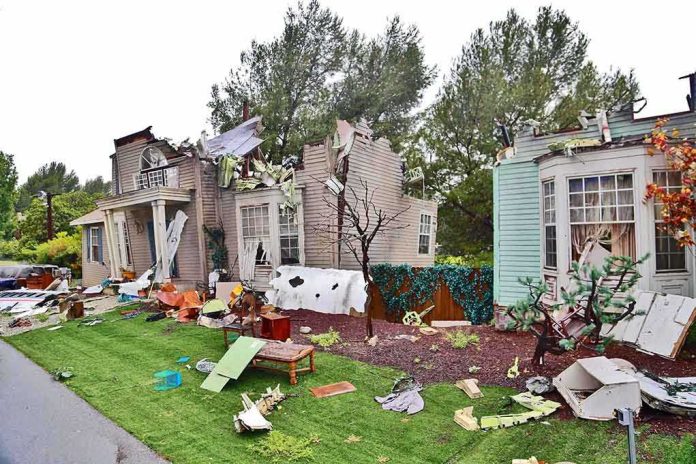
Trump’s plan to remake—rather than eradicate—FEMA is throwing America’s entire disaster response system into a firestorm of debate, as states brace for the possibility of shouldering future catastrophes with far less federal help.
At a Glance
- President Trump has ordered a sweeping review of FEMA, signaling possible dismantling or radical overhaul after the 2025 hurricane season.
- DHS Secretary Kristi Noem says FEMA “needs to go away as it exists,” pushing for states to take the reins on disaster recovery.
- Federal disaster aid is now being distributed more selectively, with an emphasis on state-led response and upfront recovery support.
- Critics warn that eliminating FEMA could create chaos and leave vulnerable communities at higher risk during major disasters.
Trump Administration Moves to Dismantle FEMA as States Face the Eye of the Storm
President Trump is shaking up the nation’s disaster response playbook by ordering a sweeping review of FEMA, with the clear message that the era of endless federal bailouts and bloated bureaucracy is coming to an end. Since January, the White House has directed the FEMA Review Council to assess whether the agency should be fundamentally reformed or even scrapped entirely after the current hurricane season. This is not just a routine audit; it’s a complete reimagining of who should pick up the pieces when disaster strikes.
With the National Oceanic and Atmospheric Administration predicting a brutal hurricane season, the stakes couldn’t be higher. Trump and DHS Secretary Kristi Noem have been blunt: FEMA is “ineffective and unnecessary,” and it’s time for state governments to step up. “We want to wean off of FEMA, and we want to bring it down to the state level,” Trump declared. According to Noem, “FEMA fundamentally needs to go away as it exists.” That’s not a nudge—it’s a bulldozer headed straight for decades of federal disaster management tradition.
States on the Front Lines as Federal Role Shrinks
This new philosophy crashed headlong into reality in July when catastrophic flooding hit Texas. Trump approved a major disaster declaration, but with a twist: the federal response was limited and clearly temporary, with the expectation that the state would lead its own recovery. This approach is now the model, not the exception. The White House, through spokesperson Abigail Jackson, has argued that “FEMA’s outsized role created a bloated bureaucracy that disincentivized state investment in their own resilience.”
No state can afford to ignore this policy shift. Governors are finding themselves with greater responsibility for disaster response, forced to rapidly scale up their emergency management capabilities without the same level of federal backstop. State budgets—already squeezed by inflation, crime, and the ongoing illegal immigration crisis—are now expected to carry the load if FEMA is phased out. Meanwhile, FEMA employees face job insecurity as their agency’s future hangs in the balance.
The Debate: A Leaner System or Recipe for Disaster?
Supporters of Trump’s plan argue that the federal government’s role in disaster response has ballooned far beyond its original purpose, enabling waste, fraud, and a culture of dependency among states that should have their own houses in order. The conservative vision: let states manage their own disasters, cut the red tape, and stop pouring taxpayer money into an ever-expanding federal bureaucracy. If a governor can’t handle a crisis, maybe it’s time for new leadership—that’s the Trump philosophy in a nutshell.
Opponents, including former FEMA officials and emergency management experts, say this is a reckless experiment that could leave less wealthy states and vulnerable communities dangerously exposed. They warn that the loss of federal coordination and resources will lead to slower, less effective disaster responses and widen the gap between rich and poor states. The academic consensus is that while states should have a leading role, federal coordination is essential for large-scale disasters that overwhelm local capabilities.
Who Pays When the Rain Falls?
The possibility of dismantling FEMA raises tough questions about who pays—and who suffers—when the next hurricane, wildfire, or flood strikes. In the short term, disaster victims may face uncertainty and delays as new systems are tested. Over the long term, the U.S. could see a surge in private emergency management contracts, higher insurance costs, and greater disparities in disaster recovery depending on where you live. The only guarantee is that the old days of automatic federal bailouts are coming to a close.
The FEMA Review Council continues its work, but the writing is on the wall: states will soon be the first, and possibly only, responders when disaster comes knocking. For those who believe in federalism, fiscal sanity, and common sense, this is a long-overdue course correction. For those who have grown dependent on Washington’s largesse, it’s a five-alarm wake-up call. As the 2025 hurricane season barrels on, all eyes are on the next storm—and who will be left holding the sandbags.



